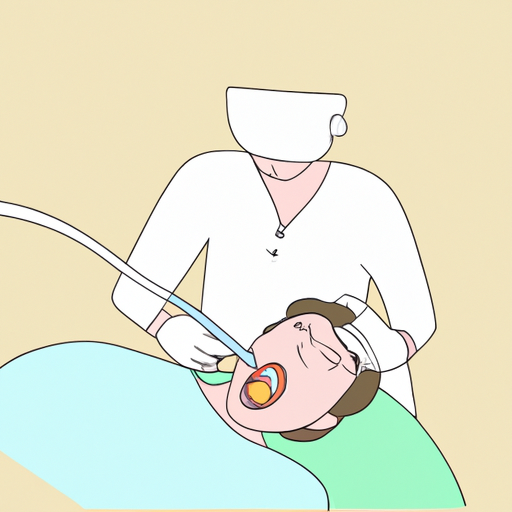- Your cart is empty
- Continue Shopping
Demystifying Dental Anesthesia: Unveiling Causes, Symptoms, Diagnosis, and Treatment Options

Dental anesthesia can be a scary and uncomfortable experience for many individuals. Whether it is due to a fear of needles or a previous negative dental experience, the thought of undergoing dental procedures can cause anxiety and stress. However, understanding the causes, symptoms, and diagnosis of dental anesthesia can help alleviate some of these fears. In this article, we will delve into the world of dental anesthesia, exploring its various aspects and shedding light on effective treatment options. Additionally, we will provide valuable tips on how to prevent dental anesthesia and maintain optimal oral health, ultimately reducing the risks associated with dental procedures. So, if you have ever wondered about the mysteries behind dental anesthesia, read on to gain a deeper understanding and take control of your dental health.
1. "Understanding Dental Anesthesia: Causes, Symptoms, and Diagnosis"
Dental anesthesia is a commonly used technique in dental procedures to numb the sensation of pain or discomfort. It is a crucial aspect of dental care, ensuring that patients can receive necessary treatments without experiencing unnecessary pain. Understanding the causes, symptoms, and diagnosis of dental anesthesia is essential for both dental practitioners and patients.
The primary cause of dental anesthesia is the administration of local anesthetic agents, such as lidocaine or articaine, into the specific area being treated. These agents work by blocking nerve signals in the area, temporarily numbing the tissues and preventing pain sensations from reaching the brain. In some cases, general anesthesia may be necessary for more complex dental procedures or for patients with severe dental anxiety.
Symptoms associated with dental anesthesia are typically related to the numbing effect. Patients may experience a loss of sensation in the treated area, including the tongue, lips, cheeks, or gums. This numbness can make it challenging to speak, eat, or drink immediately after the procedure. Additionally, patients may also experience a tingling or prickling sensation as the anesthesia wears off.
Diagnosing the need for dental anesthesia is primarily based on the type of dental procedure being performed and the patient’s comfort level. Dentists will evaluate the complexity of the treatment, the potential for pain, and the patient’s dental anxiety or sensitivity before determining the appropriate anesthesia technique. Dental professionals must also take into consideration the patient’s medical history, allergies, and any potential drug interactions.
During the diagnosis process, dentists may also consider alternative pain management techniques or adjustments to the anesthesia dosage to accommodate patients with specific medical conditions or sensitivities. It is crucial for dentists to communicate effectively with patients, explaining the benefits and risks of dental anesthesia and addressing any concerns or questions they may have.
In conclusion, dental anesthesia plays a crucial role in ensuring a pain-free dental experience for patients. Understanding the causes, symptoms, and diagnosis of dental anesthesia is essential for both dental professionals and patients. By effectively communicating and evaluating individual needs, dental practitioners can provide safe and effective anesthesia, enhancing the overall
2. "Exploring Treatment Options for Dental Anesthesia: Effective Solutions and Techniques"
Dental anesthesia, a common technique used by dentists to numb the mouth and surrounding tissues, is crucial for pain-free dental procedures. However, the diagnosis and treatment of dental anesthesia can vary depending on the specific case and patient’s needs. In this section, we will explore the various treatment options available for dental anesthesia, focusing on effective solutions and techniques.
1. Local Anesthesia:
Local anesthesia is the most commonly used technique for dental procedures. It involves injecting an anesthetic agent, such as lidocaine, directly into the site where the treatment will take place. This blocks the nerves responsible for transmitting pain signals, ensuring a painless experience for the patient. Local anesthesia is highly effective and typically wears off after a few hours, allowing patients to resume their daily activities.
2. Topical Anesthesia:
Topical anesthesia is often used in conjunction with local anesthesia to enhance patient comfort during dental procedures. It involves applying a numbing gel or ointment to the surface of the gums or oral tissues before the injection of local anesthesia. Topical anesthesia numbs the area temporarily, reducing the discomfort associated with needle insertion and the initial injection.
3. Sedation Dentistry:
For patients with dental anxiety or complex procedures, sedation dentistry offers a viable solution. It involves using medications to induce a relaxed and calm state during dental treatments. Various levels of sedation are available, ranging from minimal sedation (awake but relaxed) to general anesthesia (unconsciousness). Sedation dentistry allows patients to undergo lengthy or invasive dental procedures without anxiety or discomfort.
4. Electronic Dental Anesthesia:
Electronic dental anesthesia is a modern technique that utilizes low-frequency electrical pulses to block pain signals. This innovative approach can be an alternative or adjunct to traditional anesthesia methods. It involves placing electrodes on the skin near the treatment area, which deliver gentle electrical impulses to disrupt pain transmission. Electronic dental anesthesia is particularly useful for patients with a fear of needles or those who prefer non-invasive options.
5. Alternative Techniques:
Some patients may be allergic
3. "Preventing Dental Anesthesia: Tips for Maintaining Oral Health and Reducing Risks"
Maintaining good oral health and taking necessary precautions can help prevent the need for dental anesthesia and reduce associated risks. Here are some essential tips to follow:
1. Adopt a Consistent Dental Care Routine:
Regular brushing, flossing, and rinsing with an antimicrobial mouthwash are vital for maintaining optimal oral health. Brushing twice a day, using a soft-bristled toothbrush, and replacing it every three to four months will help prevent tooth decay, gum diseases, and the need for invasive dental procedures.
2. Schedule Regular Dental Check-ups:
Visiting your dentist regularly is crucial for preventing dental issues from escalating. Routine dental check-ups allow your dentist to identify any potential problems early on and address them promptly. This can prevent the need for extensive treatments that may require anesthesia. Your dentist will also perform professional cleanings, removing any plaque or tartar buildup that cannot be effectively eliminated through regular brushing and flossing.
3. Practice a Healthy Diet:
A balanced diet plays a significant role in maintaining oral health. Limiting sugary foods and drinks can help prevent tooth decay and cavities. Consuming a variety of nutrient-rich foods, such as fruits, vegetables, whole grains, and lean proteins, will provide essential vitamins and minerals needed for healthy teeth and gums.
4. Avoid Tobacco and Alcohol:
Tobacco use, including smoking and chewing tobacco, can increase the risk of gum diseases, oral cancers, and other dental problems. Similarly, excessive alcohol consumption can also negatively impact oral health. By avoiding these habits, you can significantly reduce the need for dental anesthesia by preventing severe oral health issues.
5. Wear Protective Gear During Sports:
Engaging in contact sports without wearing a mouthguard significantly increases the risk of dental injuries. By wearing a well-fitted mouthguard, you can protect your teeth from trauma and potentially avoid the need for dental procedures involving anesthesia.
6. Seek Early Treatment:
If you experience any symptoms of dental problems, such as toothache, sensitivity, or swollen gums, it is crucial to seek early treatment. Ign

